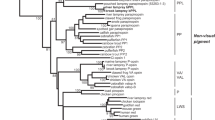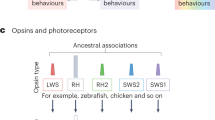Abstract
THE Purkinje shift is the displacement of the maximum sensitivity of the eye towards the blue end of the spectrum at low levels of ambient illumination. It occurs in a wide variety of vertebrates, including some which possess the porphyropsin system of freshwater fishes in place of the rhodopsin system of sea-water fishes and land vertebrates; but in spite of this widespread occurrence, there is no satisfactory explanation for the advantage derived from evolving different photosensitive systems with different spectral sensitivity curves for use at high and low levels of illumination. An explanation is not to be found in the different distribution of energy in the incident light in day-time and at night, for the maximum energy of light from the Moon is slightly to the red side of the maximum for light from the Sun. Le Grand1 suggests that rhodopsin was evolved by deep-sea fishes, for the light which penetrates deep into the sea has a maximum energy close to the peak of the absorption of rhodopsin, but a shift of the spectral sensitivity curve to the blue may enable the eye to achieve greater sensitivity for a quite different reason.
This is a preview of subscription content, access via your institution
Access options
Subscribe to this journal
Receive 51 print issues and online access
$199.00 per year
only $3.90 per issue
Buy this article
- Purchase on Springer Link
- Instant access to full article PDF
Prices may be subject to local taxes which are calculated during checkout
Similar content being viewed by others
References
Le Grand, Y., “Optique Physiologique”, 2 (Éditions de la Revue d'Optique, Paris, 1950).
Milatz, J. M. W., and Van der Velden, H. A., Physica, 10, 369 (1943). Jones, R. C., J. Opt. Soc. Amer., 37, 879 (1945); 39, 327; 39, 344 (1947). Felgett, P. B., ibid., 39, 970 (1949).
Moss, T. S., J. Opt. Soc. Amer., 40, 603 (1950). Platt, J. R., ibid., 46, 609 (1956).
Barlow, H. B., J. Opt. Soc. Amer., 46, 634 (1956).
de Vries, Hl., Documenta Ophthalmologica, 3, 137 (1949).
Stiles, W. S., Trans. Optical Convention of the Worshipful Company of Spectacle Makers, 97 (1948).
Wald, G., Science, 101, 653 (1945).
Lewis, P. R., J. Physiol., 130, 45 (1955).
Author information
Authors and Affiliations
Rights and permissions
About this article
Cite this article
BARLOW, H. Purkinje Shift and Retinal Noise. Nature 179, 255–256 (1957). https://doi.org/10.1038/179255b0
Issue Date:
DOI: https://doi.org/10.1038/179255b0
This article is cited by
-
Insect visual sensitivity to long wavelengths enhances colour contrast of insects against vegetation
Scientific Reports (2022)
-
Intraspecific geographic variation in rod and cone visual pigment sensitivity of a parrot, Platycercus elegans
Scientific Reports (2017)
-
Modulation of thermal noise and spectral sensitivity in Lake Baikal cottoid fish rhodopsins
Scientific Reports (2016)
-
Eye spectral sensitivity in fresh- and brackish-water populations of three glacial-relict Mysis species (Crustacea): physiology and genetics of differential tuning
Journal of Comparative Physiology A (2016)
-
Biophotons Contribute to Retinal Dark Noise
Neuroscience Bulletin (2016)
Comments
By submitting a comment you agree to abide by our Terms and Community Guidelines. If you find something abusive or that does not comply with our terms or guidelines please flag it as inappropriate.



